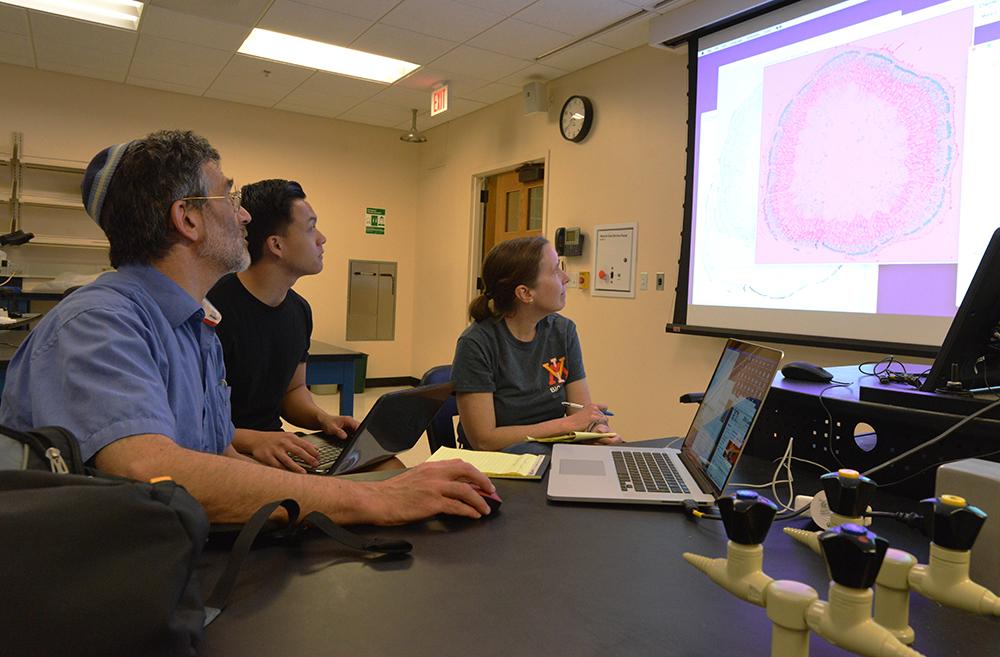Coding Botany
 |
| Dr. Aryeh Weiss (left) helps Anh duy "Anthony" Tran '17 and Lt. Col. Anne Alerding use ImageJ software to study soybean stems. -- VMI Photo by Kelly Nye. |
LEXINGTON, Va., July 25, 2016 – When Lt. Col. Anne Alerding and her biology students ran into difficulties creating viable images of soybean stems during their recent research, she decided to go off post for help. Way off post.
Enter Dr. Aryeh Weiss, who came all the way from Israel to help the VMI group solve the problem. An expert in an imaging program called ImageJ, Weiss spent a week this summer helping Alerding and her students develop a working knowledge of the program. And they made a few discoveries along the way.
“I feel grateful that he was willing to put the investment in this project,” said Alerding. “Because he came here, he is now influencing a lot of other people and spreading the knowledge. It’s really going to help all of us make advances.”
A long-term goal of Alerding’s research is to improve crop seed yields by studying stem growth as a critical factor in seed production, and several cadets have worked on the research in recent years.
Weiss is a professor of engineering at Bar-Ilan University in Israel, which, with VMI’s Department of Biology, paid for his visit. He’s also a member of the Nano Medical Center at the Institute of Nanotechnology and Advanced Materials. He is considered an expert in using ImageJ to isolate microscopic particles, having employed the program in a wide range of research, including the medical, nuclear, and astronomy fields.
Alerding and Weiss met at a conference for ImageJ users and developers in Wisconsin.
“She presented a problem I thought I could help with,” explained Weiss, who returned to Israel at the end of the second summer session but will be keeping tabs on the project via Skype. “So over the course of a year, I was able to arrange to work on the problem here and do a research collaboration.”
In the VMI Summer Undergraduate Research Institute projects, which included two cadets, Anh duy “Anthony” Tran ’17 and Mitchell Fornwald ’17, the team has written new code for ImageJ to allow the researchers to create better images of soybean stems while identifying and isolating the aspects of those stems relevant to their research. While that sounds like a great deal of work – and it was – in the long run, it saved much more labor.
“What we’re trying to avoid is spending hours tracing,” said Alerding. “The hand and human eye are not as accurate as a computer can be. Then we can help others to do the same thing so they can apply this to other complex problems.”
“It has been difficult, just learning all of the software and all of the coding and scripting,” said Tran. “I’m learning on the fly, and it has been a good experience. In biology, we don’t really get exposed to this.”
The software has revealed information about plants other than soybean.
“This goes beyond what we know about plants at the microscopic level,” said Alerding, who noted that as far as she knows this is the first such research done with ImageJ. She expects to produce an article on the new method the group developed to segment plant stems in addition to using that method in her soybean research. “I’m seeing characteristics of the tissue that are making me rethink how a plant grows and works. I’m seeing things that I never would have seen before.”
While Alerding and her crew might have been able to figure out ImageJ for themselves, especially with the help of its extensive online community, Weiss’s help was especially appreciated in writing the necessary code. And he, like Alerding, is very pleased with the outcome.
“There’s no substitute for coming to beat on the problem and think about things,” he said. “I didn’t do things exactly like I thought I would. I didn’t know when I got off the plane that this is the way we would be doing it. It’s been a very worthwhile visit.”
–Chris Floyd
-VMI-
.svg)
.png)